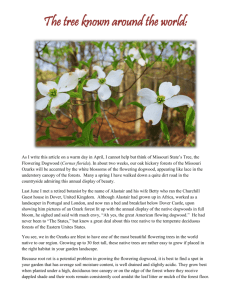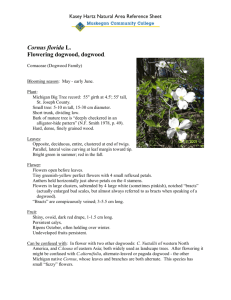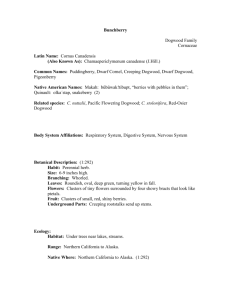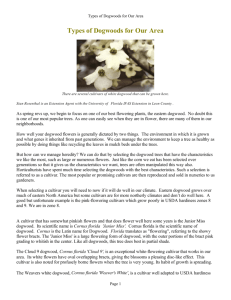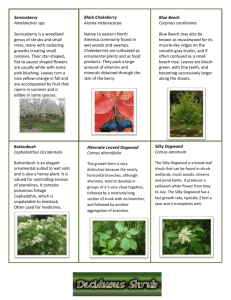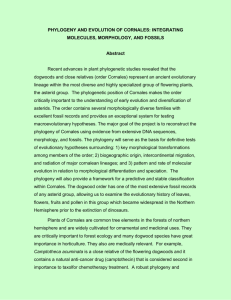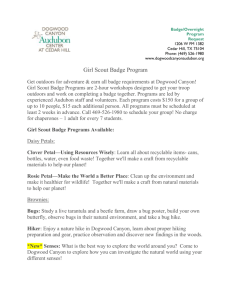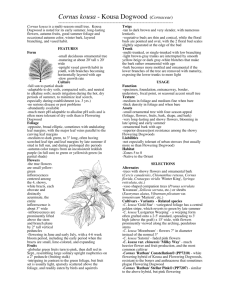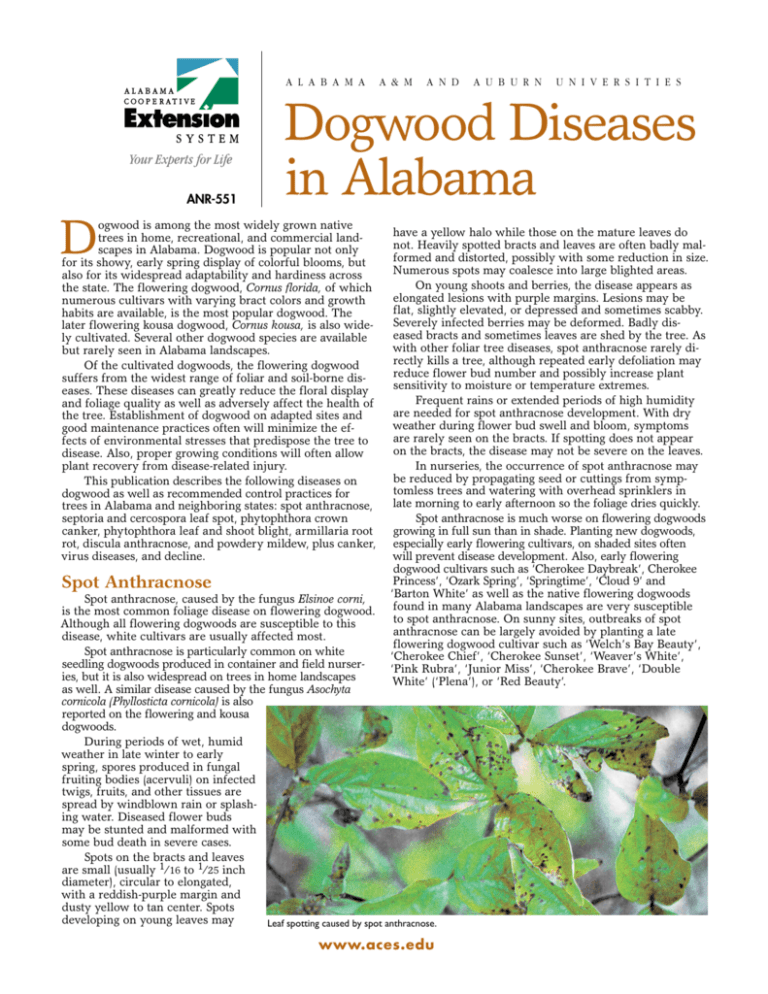
A l a b a m a
ANR-551
D
a n d
A u b u r n
U n i v e r s i t i e s
Dogwood Diseases
in Alabama
ogwood is among the most widely grown native
trees in home, recreational, and commercial landscapes in Alabama. Dogwood is popular not only
for its showy, early spring display of colorful blooms, but
also for its widespread adaptability and hardiness across
the state. The flowering dogwood, Cornus florida, of which
numerous cultivars with varying bract colors and growth
habits are available, is the most popular dogwood. The
later flowering kousa dogwood, Cornus kousa, is also widely cultivated. Several other dogwood species are available
but rarely seen in Alabama landscapes.
Of the cultivated dogwoods, the flowering dogwood
suffers from the widest range of foliar and soil-borne diseases. These diseases can greatly reduce the floral display
and foliage quality as well as adversely affect the health of
the tree. Establish­ment of dogwood on adapted sites and
good maintenance practices often will minimize the effects of environmental stresses that predispose the tree to
disease. Also, proper growing conditions will often allow
plant recovery from disease-related injury.
This publication describes the following diseases on
dogwood as well as recommended control practices for
trees in Alabama and neighboring states: spot anthracnose,
septoria and cercospora leaf spot, phytophthora crown
canker, phytophthora leaf and shoot blight, armillaria root
rot, discula anthracnose, and powdery mildew, plus canker,
virus diseases, and decline.
Spot Anthracnose
A & M
have a yellow halo while those on the mature leaves do
not. Heavily spotted bracts and leaves are often badly malformed and distorted, possibly with some reduction in size.
Numerous spots may coalesce into large blighted areas.
On young shoots and berries, the disease appears as
elongated lesions with purple margins. Lesions may be
flat, slightly elevated, or depressed and sometimes scabby.
Severely infected berries may be deformed. Badly diseased bracts and sometimes leaves are shed by the tree. As
with other foliar tree diseases, spot anthracnose rarely directly kills a tree, although repeated early defoliation may
reduce flower bud number and possibly increase plant
sensitivity to moisture or temperature extremes.
Frequent rains or extended periods of high humidity
are needed for spot anthracnose development. With dry
weather during flower bud swell and bloom, symptoms
are rarely seen on the bracts. If spotting does not appear
on the bracts, the disease may not be severe on the leaves.
In nurseries, the occurrence of spot anthracnose may
be reduced by propagating seed or cuttings from symptomless trees and watering with overhead sprinklers in
late morning to early afternoon so the foliage dries quickly.
Spot anthracnose is much worse on flowering dogwoods
growing in full sun than in shade. Planting new dogwoods,
especially early flowering cultivars, on shaded sites often
will prevent disease development. Also, early flowering
dogwood cultivars such as ‘Cherokee Daybreak’, Cherokee
Princess’, ‘Ozark Spring’, ‘Springtime’, ‘Cloud 9’ and
‘Barton White’ as well as the native flowering dogwoods
found in many Alabama landscapes are very susceptible
to spot anthracnose. On sunny sites, outbreaks of spot
anthracnose can be largely avoided by planting a late
flowering dogwood cultivar such as ‘Welch’s Bay Beauty’,
‘Cherokee Chief’, ‘Cherokee Sunset’, ‘Weaver’s White’,
‘Pink Rubra’, ‘Junior Miss’, ‘Cherokee Brave’, ‘Double
White’ (‘Plena’), or ‘Red Beauty’.
Spot anthracnose, caused by the fungus Elsinoe corni,
is the most common foliage disease on flowering dogwood.
Although all flowering dogwoods are susceptible to this
disease, white cultivars are usually affected most.
Spot anthracnose is particularly common on white
seedling dogwoods produced in container and field nurseries, but it is also widespread on trees in home landscapes
as well. A similar disease caused by the fungus Asochyta
cornicola (Phyllosticta cornicola) is also
reported on the flowering and kousa
dogwoods.
During periods of wet, humid
weather in late winter to early
spring, spores produced in fungal
fruiting bodies (acervuli) on infected
twigs, fruits, and other tissues are
spread by windblown rain or splashing water. Diseased flower buds
may be stunted and malformed with
some bud death in severe cases.
Spots on the bracts and leaves
are small (usually 1⁄ 16 to 1⁄ 25 inch
diameter), circular to elongated,
with a reddish-purple margin and
dusty yellow to tan center. Spots
developing on young leaves may
Leaf spotting caused by spot anthracnose.
www.aces.edu
Spotting and distortion of bracts caused by spot anthracnose.
In landscapes, applying a fungicide (see Table 1) every
7 to 10 days starting at bud break through bract fall will
control spot anthracnose. In nurseries, apply protective fungicides beginning at bud break until all new growth matures.
See Extension publication ANR-941, “Spot Anthracnose on
Flowering Dogwood,” for more information.
Cercospora and Septoria Leaf Spot
Leaf spot diseases caused by the fungi Septoria spp.
and Cercospora cornicola may appear on flowering dogwood anytime from midsummer to early fall following
several days of showers. The light spotting of the leaves
has little impact on tree health, but repeated defoliation
over several years may reduce tree vigor. Leaf spot damaged flowering dogwoods that lose their leaves in 2 to 3
weeks have little fall color. Septoria leaf spot is also reported on the redosier dogwood (C. stolonifera). Of these
two diseases, cercospora leaf spot is most common.
Cercospora leaf spots are angular to irregularly
shaped and tan-brown areas (1⁄ 8 to 1⁄ 4 inch diameter) with
diffuse borders. Following a heavy dew or rain shower,
numerous dark tufts of the spore-producing structures
(conidiophores) can be seen with a hand lens on the upper
surface of the leaf spot.
Table 1. Chemical Control of Spot Anthracnose
Fungicide
Rate
Per gal
Per 100 gal
azoxystrobin
Heritage 50W
chlorothalonil
Daconil Ultrex
Daconil WeatherStik 6F
Garden Fungicide
myclobutanil
Immunox
Eagle 40W
tebuconazole
Disease Control
for Roses, Flowers,
and Shrubs
thiophanate-methyl
3336 50W
3336 4.5F
—
4 to 8 oz
—
—
1.4 lb
1 3⁄ 8 pt
—
2 1⁄ 4 t.
2 T.
—
1.5 T.
2 1⁄ 2 t.
1 T.
Halt 50W
2 1⁄ 2 t.
thiophanate-methyl + mancozeb
—
3 to 6 oz
—
12 to 16 oz
10 to 20
fl oz
—
Alabama Cooperative Extension System
Comments
Foliar Spray:
Make first
application
when flower
buds show
color and
repeat every
7 to 14 days
until the
bracts fall.
On badly diseased trees,
continue
fungicide
applications
until the new
leaves mature
in mid-June.
Refer to label
for the recommended
application interval for each
fungicide.
Septoria leaf spot is very similar in appearance and
size (1⁄ 8 to 1⁄ 4 inch diameter) to cercospora leaf spot.
Initially, the spots are angular to irregular in shape, usually bordered by the leaf veins, and dark brown-purple in
color; later, they develop light brown or gray centers with
dark borders. Heavily spotted leaves may be shed early.
Damage to the fruit appears as a distortion or roughening of the seed coat. Septoria spp. produce numerous
spores in hard to find fruiting bodies (pycnidia) embedded
in the dead tissues within leaf spots.
Both cercospora and septoria fungi over-winter in diseased leaves on the ground or hanging on the tree. During
wet weather, spores will infect leaves, particularly those
in the lower portions of the tree canopy. Both diseases
will intensify during favorable weather from July until
November.
Specific control measures for cercospora and septoria
leaf spots on flowering dogwood have not been developed. Good tree management practices should prevent a
serious reduction in plant vigor resulting from early leaf
drop. Fungicides should provide good protection from both
diseases. Apply a recommended fungicide (see Table 2)
several times at 10- to 14-day intervals shortly after an extended period of rain starting in July or August. Protective
applications are suggested only on trees damaged nearly
every year by either of these diseases.
Phytophthora Crown Canker
Crown canker caused by the soil-borne fungus
Phytophthora cactorum is a destructive disease of flowering dogwood in the home landscape and field plantings
in commercial nurseries. The disease usually develops on
newly transplanted trees or those that have suffered injury
to their roots. Dogwoods with low vigor, especially those
grown on poorly drained or wet sites, are more sensitive
to crown canker; however, healthy trees may also be attacked by the crown canker fungus.
A root rot disease that may be caused by the crown
canker fungus or Phytophthora cinnamomi is also found
on field or container-grown dogwood grown in poorly
drained soils or potting mixes.
Crown canker usually is first apparent when leaf
number and size are greatly reduced. Leaves on diseased
trees are small with a pale yellow-green to red color in late
summer; they bend downward from the petiole, and fold
along the midrib, and they may shed early. Wilting and
leaf edge browning, symptoms usually associated with
drought, appear earlier on diseased dogwood than neighboring healthy trees.
A slow dieback of twigs and branches along with the
production of unusually large flowers and a heavy fruit
set is often seen on diseased trees just before their death.
Diseased dogwood may die in 1 to 2 years or they may
Angular leaf spots characteristic for Cercospora leaf spot.
Spotting on leaves caused by Cercospora leaf spot.
linger with little growth or vigor for several years. Foliar
symptoms of root rot caused by P. cinnamomi are similar to
those of crown canker.
A slow-developing canker on the lower trunk near the
ground line is characteristic of crown canker on dogwood.
During early stages of the disease, the cankers may not be
apparent except for the oozing of dark-colored fluid from
the bark at the soil line. By removing the outer bark, the
typical browning of the inner bark, cambium, and sapwood can easily be seen. Over a period of months to years,
the canker face becomes cracked and sunken, and it dries
and falls away, exposing the heartwood. As a diseased dogwood weakens, it is more susceptible to dogwood borer or
environmental stresses that often kill the tree.
Because the disease is associated with wounding of
the roots and crown, care should be taken when transplanting, cultivating, or weeding to avoid injuring the
crown and roots of dogwood. Any bark damage may be
quickly colonized by either the crown canker fungus or
dogwood borer. Disease incidence is usually lowest on
well-drained, slightly acid sites. Amending soil from the
potting hole with pine bark to a depth of 8 to 12 inches is
suggested. Container-grown dogwood should be produced
in a fast-draining soilless potting medium on crowned
beds to minimize water retention and reduce phytophthora crown canker and root rot.
In home landscapes and production fields, diseased dog-
wood should be removed and
replaced with a woody ornamental resistant to Phytophthora
spp. In container nurseries,
contaminated potting media
should be discarded and all
flats, used containers, benches,
and propagation tools should be
soaked in a surface disinfectant
such as a denatured alcohol or
a germicidal soap. Fumigation
of infested beds with metamsodium (Vapam) will reduce
but not eliminate the fungus in
the soil. Further information on
soil fumigation is discussed in
Extension publication ANR-30,
“Nematode Control in the Home Garden.”
Fungicide drenches will provide some protection from
phytophthora crown canker and root rot on container- and
field-grown dogwood, but such treatments are not practical in the home landscape. Combined with good production practices and crop sanitation, fungicide treatments
(Table 3) applied through the production cycle at intervals
specified on the product label will control this disease.
Curative treatments applied after the pathogens have become established are not effective.
Phytophthora leaf and shoot blight
Phytophthora leaf and shoot blight occurs primarily
on container-grown flowering dogwood in nurseries along
the Florida and Alabama Gulf Coast. The causal fungi
Phytophthora parasitica and P. palmivora are most aggressive on flowering dogwood during extended periods of
hot, wet weather in June, July, and August. If considerable
shoot blighting occurs, diseased flowering dogwoods are
not marketable. All cultivars of flowering dogwood appear
to be susceptible to Phytophthora leaf and shoot blight.
Randomly scattered gray-green, water-soaked
spots on the leaves are the first noticeable symptoms of
Phytophthora leaf and shoot blight. These spots quickly
expand into large, irregular brown blotches with a graygreen border that eventually cover the entire leaf. Under
hot, wet conditions, these blighted leaves quickly wither
and die. The fungus will then invade, girdle, and kill the
leaf-bearing shoots. The dead leaves are not shed in the fall
but may remain on the plant until the next spring.
Table 2. Chemical Control of Cercospora and Septoria Leaf Spot
Spacing out container-grown flowerFungicide
Rate
ing dogwood may slow tree-to-tree spread of
Comments
Per gal
Per 100 gal
Phytophthora leaf and shoot blight. During the
azoxystrobin
Foliar Spray:
summer, blocks of flowering dogwood should
Apply at first sign
be inspected weekly for symptoms and badly
Heritage 50W
—
1 to 4 oz
of disease on leaves
diseased trees should be discarded. When using
Chlorothalonil
in late July to early
overhead
sprinklers, water flowering dogwood beDaconil Ultrex
—
1.4 lb
August. Repeat
tween 2 and 6 a.m. or at mid-day. Watering in late
fungicide applicaDaconil WeatherStik 6F
—
1 3⁄ 8 pt
afternoon or early evening, especially on cloudy
tions at 10- to 14Garden Fungicide
2 1⁄ 4 t.
—
days before or after a shower will greatly increase
day intervals until
myclobutanil
the risk of disease development. Recycled water
late September to
Immunox
2 T.
—
early October. The
must be filtered and sterilized or chlorinated beapplication interval
fore being applied to nursery stock.
Eagle 40W
—
3 to 6 oz
for Heritage 50W is
tebuconazole
Flowering dogwood can be protected from
14 to 28 days.
Phytophthora leaf and shoot blight with the fungiDisease Control for Roses,
1.5 T.
—
Flowers, and Shrubs
cide listed in Table 4. Inspect blocks of containergrown flowering dogwood weekly and begin funthiophanate-methyl
gicide applications when symptoms first appear.
3336 50W
2 1⁄ 2 t.
12 to 16 oz
Continue applications at the interval specified for
3336 4.5F
1 T.
10 to 20
each fungicide until weather pattern no longer
fl oz
Halt 50W
2 1⁄ 2 t.
—
Dogwood Diseases in Alabama favors disease development. An alternative would be to
begin making protective fungicide treatments in mid to
late May and continue treating the trees until weather patterns become cooler and drier in mid-September.
Armillaria Root Rot
Armillaria root rot, otherwise known as mushroom
root rot or shoestring root rot, is occasionally seen on
dogwood. The causal fungus, Armillaria tabescens (A. mellea), usually is found in landscape sites where oaks or
other hardwoods once were or are now established. Many
woody plants, such as dogwood, photinia, arborvitae,
camellia, elm, grape, loquat, southern magnolia, silver
maple, Russian olive, pittosporum, loblolly pine, and several oaks including laurel, post, red, turkey, water, and
willow are hosts of this fungus.
The ability of Armillaria to attack plants depends
largely on the health of the tree or shrub host. Tree and
shrub roots weakened by drought are readily colonized by
the Armillaria fungus. Reports indicate that insect or dis-
ease defoliation, mechanical (construction) injury, and air
pollution may also increase plant susceptibility to attack
by A. tabescens.
Root rot may appear on one or more dogwood in a
given site. Yellowing, sparse foliage, slowed top growth,
shoot dieback, and defoliation are early root rot symptoms. Distinct semi-circular, sunken lesions with a cracked
margin may be seen at or just above the soil line of trees
and shrubs with a thin bark. Small trees often succumb
suddenly to this disease while some trees can withstand
severe damage for years.
A white fan-like mat of fungal mycelia under the bark
is diagnostic for mushroom root rot. These mats are often
seen at or just above the soil line, but they may extend
several feet up the trunk. Branched, string-like, brown to
black structures called rhizomorphs often are found growing on the surface of the roots, root collar, and into the soil
surrounding the affected plants. Flat­tened rhizomorphs
may also form under the root and root collar bark.
Mushrooms are produced on or near the roots of dis-
Table 3. Control of Phytophthora Collar and Root Rot
Fungicide
Rate
Per gal
Per 100 gal
Comments
fosetyl-Al
Aliette 80WDG
—
8 to 12.8 oz.
—
6.4 to 12.8
oz
—
2.5 to 5.0 lb
Subdue Maxx
—
1 to 2 fl oz
Subdue GR
—
26 to 125 oz
1.5 t.
25 fl oz
Dry Soil Mixture: Use
on well-rooted plants.
Thoroughly incorporate
fungicide into potting
medium before planting
or stepping up liners
and container material.
Begin protective soil
drenches or spray 1
month after treatment.
Drench: Apply 2.0
quarts of fungicide
suspension per square
foot of bed area. Repeat
as needed but do not
exceed one application
every 30 days.
Foliar Spray: Apply
as needed but do not
exceed one application every 30 days. Do
not mix with sticker,
extended, or wetting
agent.
Phytophthora leaf and shoot blight on ‘Cloud 9’ dogwoods.
Mefenoxam
Soil Drench: Apply
11⁄ 2 to 2 pints of drench
solution per plant
treated at 2- to 3-month
intervals.
Broadcast: Apply to
1,000-square-foot area
and thoroughly wet
soil. Repeat application
every 2 to 4 months as
needed.
Phytophthora leaf and shoot blight on ‘Cloud 9’ dogwoods.
propamocarb
Banol 67S
Soil Drench: Apply 5
quarts of drench solution to a 10-square-foot
area. Repeat every 3 to
4 months as needed to
control disease.
Alabama Cooperative Extension System
Woody plants such as dogwood and photinia are hosts to fungus that
causes armillaria root rot.
Table 4. Control of Phytophthora Leaf and Shoot Blight
Fungicide
Rate
Per gal
Per 100 gal
azoxystrobin
Heritage 50W
—
1 to 4 oz
chlorothalonil
Daconil Ultrex
—
1.4 lb
Daconil
WeatherStik 6F
Garden Fungicide
—
1 3⁄ 8 pt
2 1⁄ 4 t.
—
Foliar Spray:
Apply every 14
to 28 days when
conditions favor
disease. Occurs
during extended
periods of hot,
wet weather in
July and August
on containergrown dogwood.
Mushrooms of Armillaria tabescens appear in the fall around the base
of the diseased tree.
Foliar Spray:
Apply every 7
to 14 days when
conditions favor
disease.
—
fosetyl-Al
Aliette 80WDG
Comments
2.5 to 5.0
lb
Foliar Spray:
Apply as needed
but do not exceed
one application
every 30 days.
Do not mix with
sticker, extended,
or wetting agent.
eased plants in clusters of several to 100. The common
name, honey fungus, refers to the honey-colored cap of
the armillaria mushrooms.
Mushrooms usually appear in the fall up to early winter. Dry fall weather often delays mushroom formation
until the following year. Mushroom root rot fungi persist
as mycelia in diseased roots and rhizomorphs. Tree stumps
are particularly important survival sites and food bases
for the fungus in both landscape and orchard settings. The
rhizomorphs grow through the soil to the roots of nearby
trees and shrubs. Infection of the roots usually occurs
after stress. Airborne spores produced in the mushrooms
have limited impact on disease spread, although colonization of freshly cut tree stumps is reported.
Good tree vigor is the best defense against armillaria
root rot. Recommended fertilization and watering practices should be followed to promote tree vigor and reduce
the effect of environmental stresses. Dogwood should be
established on sites best adapted for good tree growth.
Uprooting stumps and root remnants is recommended as
a means of slowing disease spread to nearby healthy trees.
Several trees resistant to armillaria root rot are available
for establishment on infested sites. See Extension publication ANR-907, “Armillaria Root Rot of Trees and Shrubs,”
for more information.
Discula Anthracnose
First reported on flowering dogwood (Cornus florida)
in New York and on Pacific dogwood (Cornus nuttallii) in
Washington in the mid- to late 1970s, discula anthracnose
caused by the fungus Discula sp. has spread into northern Georgia, eastern Tennessee, and into northeastern
Alabama, resulting in the loss of numerous flowering dogwoods. The worst tree decline and mortality in Alabama
occurred on forested sites in Calhoun, Cherokee, Cleburne,
DeKalb, Jackson, Madison, and Marshall counties particularly at elevations above 1,200 feet. Some damage but no
tree death has been noted in this area in home landscapes.
Dogwood anthracnose leaf spotting and shoot dieback.
In the southeastern states, this disease occurs primarily in
forest settings, but it also may be seen in landscape plantings. Despite the unknown origin of this disease, it has
quickly become the predominant disease in native stands
of dogwood along the Atlantic seaboard.
The first symptoms occur on bracts when rainy conditions occur during flowering or on leaves in the lower
canopy of the tree. Spots on the bracts are similar to those
of spot anthracnose. Tan spots with purple margins (1⁄ 16to 1⁄ 4-inch diameter) appear on the leaves. Black or brown
discoloration of the veins and leaf margins and large
brown blotches may also be seen. Tiny red to dark brown
fruiting bodies (condiomata) often develop within the leaf
spots or blotches.
During humid weather, white to orangy brown spore
masses exude from the red-brown fruiting bodies. Shot
holes may appear where the center of the spot has disintegrated. The blighted leaves are not shed but remain on the
tree into the following spring.
In the spring, shoots may be invaded by the fungus
through cracks or wounds, forming small cankers that
may encircle (girdle) the stem and result in twig dieback.
A purple margin or zone often marks the boundary between the healthy and infected tissues. Several years after
the first symptoms, brown, elliptical cankers form on
main branches and the trunk at the base of dead twigs.
Bark splitting and swellings with some discoloration of the
underlying tissues may be associated with the trunk cankers. Multiple branch and trunk cankers can kill the entire
tree. On dying trees, numerous succulent water sprouts
(epicormic shoots), which usually are quickly infected, appear on the lower branches or trunk.
Generally, this disease begins in the lower limbs and
gradually moves up through the tree canopy. Each spring
numerous spores are produced on diseased leaves as well
as some blighted twigs. These spores are spread to healthy
leaves and shoots by wind-blown rain. Cool, wet spring
Dogwood Diseases in Alabama Early symptoms of dogwood anthracnose on leaves.
Blighted leaves are not shed by tree.
and fall weather favors discula anthracnose, but disease
development has been seen throughout the growing season. Dogwoods weakened by drought or temperature extremes may be more susceptible to this disease.
Nearly all native selections and most cultivars of the
flowering dogwood (Cornus florida) and Pacific dogwood (C.
nuttalli) are susceptible to discula anthracnose. The flowering dogwood ‘Appalachian Spring’ is highly resistant to
dogwood anthracnose. The redosier dogwood (C. sericea)
cultivars ‘Kelseyi’ and ‘Flaviramea,’ along with the kousa
dogwood (C. kousa) cv. ‘Chinensis,’ and Tatarian dogwood (C.
alba) cv. ‘Elegantissma Variegator,’ are also susceptible to this
disease. The hybrid dogwood (C. florida × kousa) selections
‘Stardust,’ ‘Stellar Pink,’ and ‘Celestial,’ along with the kousa
dogwood cultivars ‘Steeply’ and ‘Milky Way,’ have good
resistance to discula anthracnose. Kousa dogwood cultivars
with intermediate disease resistance include ‘Milky Way
Select,’ ‘Gay Head,’ ‘Julian,’ ‘Temple Jewel,’ and ‘Elizabeth
Lustgarten.’ The hybrid dogwood ‘Consellation’ also has
some resistance to discula anthracnose. Some other discula
anthracnose-resistant dogwood including several selections
of the Corneliancherry dogwood (C. mas), silky dogwood (C.
amonum), C. augustata, redosier dogwood (C. sericea) ‘Ruby,’
and pagoda dogwood (C. alternifolia).
Discula anthracnose is much more damaging to flowering dogwood grown under heavy shade than those trees
found in partial shade to full sun. In areas of northeast
Alabama where this disease is common, plant new flowering dogwoods or other susceptible dogwood selections
in partial shade, especially those areas that get plenty of
morning sun, to full sun. On heavily shaded sites in this
same area, plant only disease resistant selections of the
kousa dogwood, hybrid dogwood (C. kousa × florida), or
other dogwood species.
Following recommended management and watering
practices will lessen the impact of discula anthracnose
on tree health. Dogwoods should be fertilized according
to soil test recommendations and surface watered during
extended periods of hot, dry weather. Mulching around
the tree will reduce water needs and minimize the risk of
mechanical damage from mowers or trimmers. Selective
pruning of overhanging branches on trees surrounding established dogwoods increases air circulation and sunlight
penetration, which speeds the evaporation of moisture or
dew from the foliage, thereby creating an environment
less favorable for disease development. In addition, blighted twigs should be removed and discarded off-site before
cankers develop on the branches or trunk. Fallen leaves
from diseased trees also should be collected and discarded.
Fungicides, which will protect susceptible dogwoods
from discula anthracnose, are recommended only on those
heavily shaded sites where the trees have been previously
damaged by this disease. For effective disease control,
apply a fungicide (see Table 4) beginning at bud break
until the leaves mature every 7 to 14 days. For optimum
protection of valuable specimen dogwoods in heavily
infested areas of northeast Alabama, applications of a recommended fungicide may be continued through the growing season until frost.
Alabama Cooperative Extension System
Powdery Mildew
Powdery mildew is the most widespread disease of
flowering dogwood (Cornus florida) in Alabama and surrounding states. The powdery mildew fungus (Oidium
sp.) has been equally damaging to dogwoods growing on
heavily shaded sites to those found in full sun. Although
the blemished foliage of diseased dogwoods is unsightly,
powdery mildew may have little if any effect on the vigor
of established flowering dogwood. However, noticeable
stunting and occasionally death have been observed in
seedling flowering dogwood.
Small, faint white patches of the thread-like hyphae of
the powdery mildew fungus first appear in late spring to
early summer on the upper surface of expanding and mature leaves. On susceptible dogwoods, the surface of numerous leaves may be covered with white, cottony fungal
growth. Such heavily colonized leaves usually are twisted
or distorted. On disease-resistant dogwoods, a few, scattered colonies of the causal fungus usually will not blemish the leaves. Symptoms may continue to appear on new
growth throughout the summer and into early fall.
Disease resistant cultivars offer the best long-term
control for powdery mildew on dogwood. Of all commonly cultivated species of dogwood, the flowering dogwood (C. florida) is most susceptible to powdery mildew.
Susceptibility of individual native flowering dogwoods
does considerably differ; trees with severely distorted foliage are often found adjacent to dogwoods with little or no
Discoloration of the sapwood at base of a blighted shoot.
fungicide (see Table 5) when the characteristic fungal
colonies or distortion of the new leaves are first noticed.
Reapply the fungicide every 7 to 14 days until the leaves
have matured or conditions no longer favor disease spread.
See Extension publication ANR-1051, “Powdery Mildew
on Flowering Dogwood,” for more information.
Dogwood Canker
Powdery mildew—damaged leaves on flowering dogwood.
apparent symptoms. When transplanting native dogwoods
from wooded areas into home landscapes, only dig trees
with healthy foliage. The flowering dogwood cultivars
‘Cherokee Brave’, ‘Jean’s Appalachian Snow’, and ‘Karen’s
Appalachian Blush’ have excellent resistance to powdery
mildew. Moderately resistant cultivars include ‘Barton
White’, ‘Cherokee Chief’, ‘Cloud 9, ‘Double White’,
‘Weaver's White’, and ‘Welch's Bay Beauty’. Moderate
to severe mildew infestations were seen on a number of
widely available cultivars of flowering dogwood such as
‘Cherokee Sunset’, ‘Dwarf White’, ‘First Lady’, ‘Junior
Miss’, ‘Ozark Spring’, ‘Pink Beauty’, ‘Purple Glory’, ‘Red
Beauty’, ‘Pink Rubra’, and ‘Stoke’s Pink’.
Several kousa dogwood (C. kousa) cultivars also are resistant to powdery mildew. In recent field trials, the kousa
dogwood cultivars ‘Milky Way,’ ‘Milky Way Select,’ and
‘National’ have remained nearly free of disease symptoms.
In addition, the cultivars ’Gay Head,’ ‘Julian,’ ‘Temple
Jewel,’ ‘Big Apple,’ ‘Greensleeves,’ and ‘China Girl’ along
with the recently released hybrid dogwoods ‘Stellar Pink,’
‘Star Dust,’ ‘Galaxy,’ ‘Aurora,’ and ‘Constellation’ have also
been shown to have good disease resistance. The giant dogwood (C. controversa) may be immune to powdery mildew.
In the landscape, fungicides can be used to control
powdery mildew on established flowering dogwoods.
Fungicide applications are suggested only on valued specimen trees that have previously been damaged by this
disease. As the trees leaf out in the spring, inspect the foliage weekly for disease symptoms. Apply a recommended
Dogwood canker, a serious disease of unknown cause,
was first reported on stems and trunks of white flowering dogwood in Virginia in 1969. Since then, this disease
has been seen in several southeastern states, including
Tennessee, where considerable effort has been made in
recent years to identify the causal agent. Dogwood canker
has not been found in Alabama, but diseased trees have
been found in several Tennessee counties bordering the
state. This disease has been identified on trees in landscapes, field nurseries, and forest settings.
Canker has been reported to occur as two distinct
symptom types. Some trees show sunken bark areas that
girdle the stems or trunks, eventually killing the upper
canopy of the tree. Other trees display rough areas of bark
with associated swellings in two or more locations along
the trunk or main branches. Often these roughened, swollen cankers are invaded by insects.
Control of dogwood canker involves removal of cankered limbs or trees. When establishing dogwoods, homeowners should carefully select trees free of any swellings
or cankers on the limbs and trunks.
Virus Diseases Of Dogwood
To date, six viruses have been found to infect dogwood, but only two, cherry leaf roll virus and arabis mosaic virus, cause definite symptoms on the foliage. Because
of the few reports of dogwoods with virus-like symptoms,
these diseases are considered unimportant.
Cherry leaf roll virus (CLRV) may cause a variety
of symptoms on dogwood leaves, including ringspots,
mosaics, and oak-leaf patterns. Some twisting of bracts
has been associated with CLRV infections of dogwood.
Generally symptoms occur early in the spring and disappear as the weather warms. Research also has shown that
this virus may cause significant stunting of dogwood.
Arabis mosaic virus (ArMV)
Table 5. Chemical Control of Dogwood Anthracnose
causes yellowed leaf tips or a light
Fungicide
Rate
green and white mosaic.
Per gal
Per 100 gal Comments
It is not known how these
azoxystrobin
Foliar Spray: Apply at first
viruses are transmitted in nature,
sign of disease and repeat apbut both viruses have a wide host
Heritage 50W
—
1 to 4 oz
plications every 14 to 28 days
range. Dogwoods might serve as
until the new leaves mature.
over-wintering hosts in some cases
for these viruses.
chlorothalonil
Foliar Spray: Begin applications at bud break or at the
Because virus infections of dogDaconil Ultrex
—
1.4 lb
first sign of the disease and
wood are rare, no preventive mea3
Daconil WeatherStik 6F
—
1 ⁄ 8 pt
repeat at 7- to 14-day intervals
sures are really necessary. When
until the new leaves mature.
Garden Fungicide
2 1⁄ 4 t.
—
establishing dogwoods, inspect the
The application interval for
foliage for unusual color patterns
myclobutanil
Banner Maxx is 14 to 21 days.
on the leaves. Removal of diseased
Immunox
2 T.
—
trees in home landscapes may slow
further disease spread.
propiconazole
Banner Maxx
Systemic Fungicide
—
1 T.
2 to 4 fl oz
—
tebuconazole
Disease Control for
Roses, Flowers, and
Shrubs
—
Dogwood Decline
A number of factors other than
disease may contribute to the decline of dogwood in landscape settings. With a shallow root system,
Dogwood Diseases in Alabama well-rotted sawdust, or leaf compost to two parts of soil. The
hole should be deeper and wider than the root ball to ensure
good root development. Planting shallow-rooted trees and
shrubs like dogwood too deep is a common mistake made
by many homeowners. Firming the soil while filling the
hole should minimize settling of the root ball below the soil
surface. After planting, the root ball should sit at or slightly
above the soil level.
A 2- to 3-foot circle around the base of new and established dogwoods should be mulched with rotted sawdust,
pine straw, or aged pine bark to hold moisture in the soil
and prevent mechanical injury to the base of the trunk by
mowers and other equipment. Occasional heavy watering
is needed on new trees. Established trees should be watered about every 5 to 7 days during extended periods of
hot, dry weather. Surface irrigate slowly to get water to all
the roots.
Table 6. Chemical Control of Powdery Mildew
Dogwood decline as indicated by a marginal leaf burn.
dogwoods are highly sensitive to drought conditions—particularly newly planted trees in full sun—and tree death
is not uncommon. The effects of a water shortage on tree
health are aggravated by the increased demand for water
by the trees exposed to high temperatures. Poor site selection and improper tree establishment also greatly increase
the sensitivity of dogwood to drought stress. Wounding of
dogwood with mowers and other lawn tools (for example,
weedeaters) also may kill the tree or favor invasion of
trunk wounds by the dogwood borer. The kousa dogwood,
a tree well adapted to temperate climates, has sometimes
proven sensitive to low temperature winter injury following a warm fall.
Poor foliage color, unthrifty plant growth, twig dieback, and possibly tree death are typical symptoms of
dogwood decline. An upward folding of the leaves at the
mid-rib and downward at the tip are often seen on trees
suffering from drought during the hot summer months.
Later, a marginal leaf burn characterized by the browning
of the tissues around the edge of the leaves may develop
on severely stressed trees. Some defoliation may also be
seen. The oldest leaves often are the first to show the effects of heat and drought stress. Death, particularly of
recently transplanted dogwood, will occur unless the trees
are properly watered.
Dieback and bark splitting are typical symptoms of
cold injury on both the kousa and flowering dogwood.
Bark splitting is usually seen on the south or southwestern
sides of the tree trunk.
Dogwood decline often can be prevented by following good tree establishment and maintenance practices.
Dogwoods are an understory tree in forest settings and are
best adapted to well-drained, slightly acidic soils on partially to fully shaded sites in home landscapes. Well-caredfor trees will, however, prosper in full sun.
Newly established dogwoods are especially sensitive to
extreme heat and drought conditions. Planting dogwood in
the fall rather than in the spring allows the tree enough time
to grow a good root system, thereby increasing its chances
of surviving Alabama’s hot summers. Burlapped and container-grown trees are usually easier for homeowners to successfully establish than bare-root dogwoods.
Poor site preparation often accounts for the poor growth
or death of dogwood. Add lime and fertilizers according to
soil test recommendations and deeply work the soil. Amend
sandy soils with one part peat moss, finely milled pine bark,
azoxystrobin
Heritage 50W
—
1 to 4 oz
Immunox
2 T.
—
Eagle 40W
—
3 to 6 oz.
myclobutanil
propiconazole
Banner Maxx
—
2 to 4 fl oz
1 T.
—
1.5 T.
—
3336 50W
2 1⁄ 2 t.
3336 4.5F
1 T.
12 to 16
oz
10 to 20
fl oz
—
Systemic Fungicide
tebuconazole
Disease Control for Roses,
Flowers, and Shrubs
thiophanate-methyl
Halt 50W
2 1⁄ 2 t.
thiophanate-methyl + mancozeb
Foliar Spray:
Make first application when
flower buds show
color and repeat
every 7 to 14 days
until the bracts
fall. On badly
diseased trees,
continue fungicide applications
until the new
leaves mature in
mid June. Refer to
label for the recommended application interval for
each fungicide.
ANR-551
Austin Hagan, Extension Plant Pathologist, Professor, and Jackie Mullen,
Extension Plant Pathologist and Diagnostician, both in Entomology and Plant
Pathology, Auburn University
The authors are grateful to A. Windham, University of Tennessee, for dogwood anthracnose photographs.
Use pesticides only according to the directions on the label. Follow all directions, precautions, and restrictions that
are listed. Do not use pesticides on plants that are not listed on the label.
The pesticide rates in this publication are recommended only if they are registered with the Environmental
Protection Agency and the Alabama Department of Agriculture and Industries. If a registration is changed or cancelled, the rate listed here is no longer recommended. Before you apply any pesticide, check with your county
Extension agent for the latest information.
Trade names are used only to give specific information. The Alabama Cooperative Extension System does not endorse or guarantee any product and does not recommend one product instead of another that might be similar.
For more information, call your county Extension office. Look in your telephone directory under your county’s
name to find the number.
Issued in furtherance of Cooperative Extension work in agriculture and home economics, Acts of May 8 and June
30, 1914, and other related acts, in cooperation with the U.S. Department of Agriculture. The Alabama Cooperative
Extension System (Alabama A&M University and Auburn University) offers educational programs, materials, and
equal opportunity employment to all people without regard to race, color, national origin, religion, sex, age, veteran
status, or disability.
5M, Reprinted June 2006, ANR-551
© 2006 by the Alabama Cooperative Extension System. All rights reserved.

